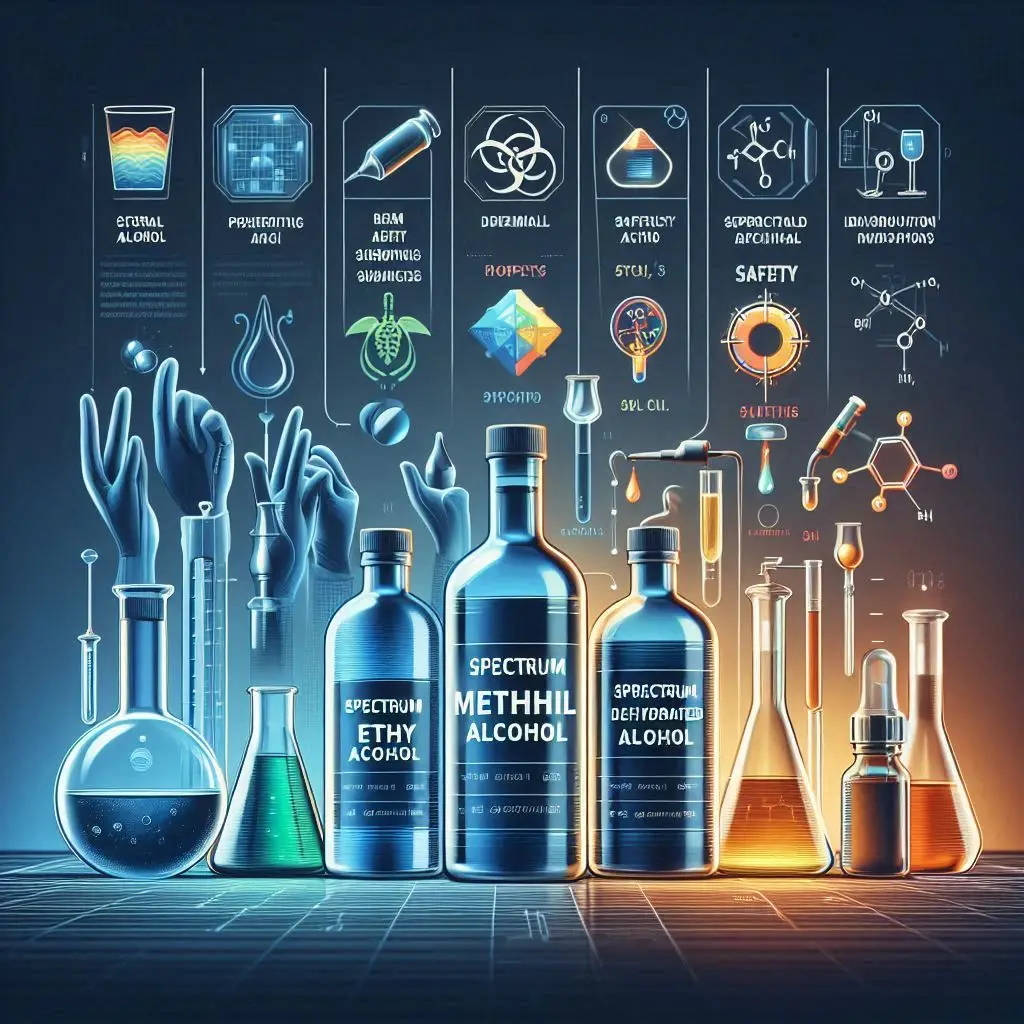
Spectrum Methyl Alcohol Ethyl SDS Dehydrated
Introduction
This article explores the specific characteristics, uses, and safety considerations of Spectrum Methyl Alcohol, Spectrum Ethyl Alcohol SDS, and Spectrum Dehydrated Alcohol. Understanding these substances' properties and safety guidelines is essential for laboratory professionals and industries that rely on these chemicals.
In the world of laboratory chemicals, various substances are essential for multiple applications. Among these, methyl alcohol (methanol), ethyl alcohol (ethanol), and dehydrated alcohol are prominent due to their widespread use and versatility. Safety Data Sheets (SDS) play a crucial role in ensuring these chemicals' safe handling, storage, and disposal.
Spectrum Methyl Alcohol
Methyl alcohol, commonly known as methanol, is a simple alcohol with the chemical formula CH3OH. It is a colorless, volatile liquid with a distinctive odor, often used as a solvent, antifreeze, and fuel. In the laboratory, methanol is prized for its ability to dissolve a wide range of substances, making it a valuable reagent in various chemical reactions.
In industrial settings, carbon monoxide is hydrogenated to make methanol. It also comes from the distillation of wood, which is why its original name was "wood alcohol." Because of its extreme toxicity, methanol poses a serious risk to human health and may cause blindness and even death when consumed or exposed to it for an extended period. As a result, while handling methanol, careful handling techniques and safety precautions are essential.
In the laboratory, methanol is often used in chromatography, spectroscopy, and as a mobile phase in high-performance liquid chromatography (HPLC). Its properties as a solvent make it essential for the synthesis of organic compounds. Additionally, methanol is used in the production of biodiesel and as a denaturant for ethanol.
Safety measures when handling methanol include using appropriate personal protective equipment (PPE), such as gloves and goggles, ensuring proper ventilation, and storing methanol in tightly sealed containers away from heat sources. In case of spills, it is crucial to clean them up immediately using appropriate absorbent materials and to avoid ignition sources, given methanol's flammability.
Spectrum Ethyl Alcohol SDS
Ethyl alcohol, or ethanol, is a widely used alcohol in various industries, including pharmaceuticals, cosmetics, and as a fuel additive. Its chemical formula is C2H5OH. Unlike methanol, ethanol is less toxic and is the type of alcohol found in alcoholic beverages. However, it still requires careful handling and adherence to safety guidelines.
The Safety Data Sheet (SDS) for Spectrum Ethyl Alcohol provides comprehensive information on its hazards, first-aid measures, firefighting techniques, accidental release measures, and proper storage and handling procedures. The SDS is a critical document for ensuring the safe use of ethanol in the laboratory and industrial settings.
Ethanol is a versatile solvent, capable of dissolving both polar and non-polar substances. This property makes it invaluable in the preparation of pharmaceuticals, where it is used as a solvent, preservative, and disinfectant. In the cosmetic industry, ethanol is used in perfumes and personal care products due to its volatility and antimicrobial properties.
The SDS for ethanol highlights the need for appropriate PPE, such as gloves, goggles, and lab coats, to protect against skin and eye contact. It also emphasizes the importance of good ventilation to prevent the buildup of ethanol vapors, which can be flammable. In the event of a spill, the SDS outlines the steps for containment and cleanup to minimize the risk of fire and exposure.
Proper storage of ethanol involves keeping it in a cool, well-ventilated area, away from ignition sources and incompatible materials. The SDS also details the potential health effects of ethanol exposure, which can include irritation of the eyes, skin, and respiratory system, as well as central nervous system effects if ingested in large quantities.
Spectrum Dehydrated Alcohol
Dehydrated alcohol, also known as absolute alcohol, is ethanol that has had nearly all of its water content removed, resulting in a concentration of at least 99.5%. This highly pure form of ethanol is used in applications where the presence of water could interfere with chemical reactions or processes.
The production of dehydrated alcohol typically involves azeotropic distillation, where water is removed from ethanol using a drying agent, such as benzene or cyclohexane. The resulting product is a potent solvent with a wide range of industrial and laboratory uses.
In the pharmaceutical industry, dehydrated alcohol is used as a solvent and in the preparation of tinctures and extracts. Its high purity makes it ideal for use in laboratories for analytical and preparative techniques, such as chromatography and spectroscopy. Dehydrated alcohol is also used in the electronics industry for cleaning and degreasing components.
Handling dehydrated alcohol requires strict adherence to safety protocols due to its high flammability and potential health risks. Appropriate PPE, such as gloves and goggles, should be worn to prevent skin and eye contact. Good ventilation is necessary to prevent the buildup of flammable vapors, and dehydrated alcohol should be stored in a cool, well-ventilated area away from ignition sources.
In case of spills, immediate cleanup with appropriate absorbent materials is essential to prevent fire hazards. Dehydrated alcohol's SDS provides detailed information on first-aid measures, firefighting techniques, and accidental release measures, ensuring that users can respond effectively to emergencies.
Conclusion
Understanding the properties, uses, and safety considerations of Spectrum Methyl Alcohol, Spectrum Ethyl Alcohol SDS, and Spectrum Dehydrated Alcohol is crucial for their safe and effective use in various applications. Methyl alcohol's versatility as a solvent, the comprehensive safety guidelines provided in the SDS for ethyl alcohol, and the high purity of dehydrated alcohol make these substances invaluable in laboratory and industrial settings. Adhering to proper handling procedures and safety protocols ensures that these chemicals can be used safely and effectively, minimizing risks to health and safety. By following the guidelines outlined in this article, users can confidently work with these essential chemicals, leveraging their unique properties while maintaining a safe working environment.

